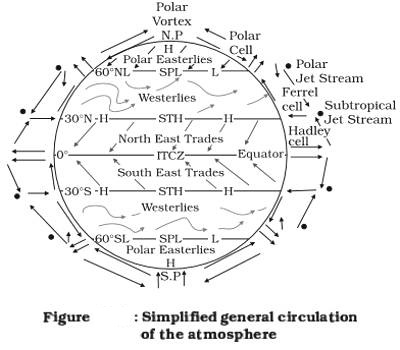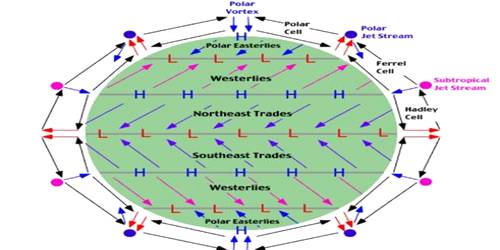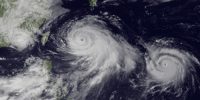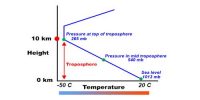General circulation of the atmosphere
The circulation of wind in the atmosphere is driven by the rotation of the earth and the incoming energy from the sun. Wind circulates in each hemisphere in three distinct cells which help transport energy and heat from the equator to the poles. The pattern of planetary winds largely depends on:
(i) latitudinal variation of atmospheric heating;
(ii) the emergence of pressure belts;
(iii) the migration of belts following an apparent path of the sun;
(iv) the distribution of continents and oceans;
(v) the rotation of the earth.
The pattern of the movement of the planetary winds is called the general circulation of the atmosphere. The general circulation of the atmosphere also sets in motion the ocean water circulation which influences the earth’s climate. A schematic description of the general circulation is shown in the figure.

The air at the Inter-Tropical Convergence Zone (ITCZ) rises because of convection caused by high insolation and a low pressure is created. The winds from the tropics converge at this low-pressure zone. The converged air rises along with the convective cell. It reaches the top of the troposphere up to an altitude of 14 km. and moves towards the poles. This causes accumulation of air at about 30° N and S. Part of the accumulated air sinks to the ground and forms a subtropical high. Another reason for sinking is the cooling of air when it reaches 30° N and S latitudes. Down below near the land surface the air flows towards the equator as the easterlies. The easterlies from either side of the equator converge in the Inter-Tropical Convergence Zone (ITCZ). Such circulations from the surface upwards and vice-versa are called cells. Such a cell in the tropics is called Hadley Cell. In the middle latitudes, the circulation is that of sinking cold air that comes from the poles and the rising warm air that blows from the subtropical high. At the surface, these winds are called westerlies and the cell is known as the Ferrel cell. At polar latitudes, the cold dense air subsides near the poles and blows towards middle latitudes as the polar easterlies. This cell is called the solar cell. These three cells set the pattern for the general circulation of the atmosphere.
The general circulation of the atmosphere also affects the oceans. The large-scale winds of the atmosphere initiate large and slow-moving currents of the ocean. Oceans, in turn, provide input of energy and water vapour into the air. These interactions take place rather slowly over a large part of the ocean.















